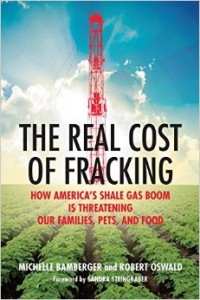Environmental hazards from fracking may extend well beyond drilling sites
From an Article by Jessica Cohen, The Utne Reader, Fall 2014
Pramilla Malick was reading in bed last summer when suddenly she had to struggle to breathe. Gasping, she went outside and then back inside, getting no relief from the country air around her home in Minisink, New York. Her symptoms began at a time when her children and some of their Minisink neighbors were also experiencing new ailments, such as nausea, nosebleeds, rashes, sore throats, asthma and dizziness. Their symptoms would erupt during or after an “odor event,” a period of malodorous emissions at the new Millennium Pipeline gas compressor station nearby that began functioning in June of 2013. Malick’s asthmatic symptoms, which she never had before, surface only on weekends in Minisink, she says; they live in New York City, 95 miles away, on weekdays.
The community’s ailments mirror those of the Parr family, living near Aruba Petroleum’s hydraulic fracturing (gas fracking) sites in Wise County, Texas. In April the family was awarded $2.95 million in a lawsuit alleging that environmental contamination from drilling sickened them and killed their pets and livestock, compelling them to leave their home. The maladies of Minisink residents suggest that environmental hazards from fracking may extend well beyond drilling sites.
Malick is a member of Minisink Residents for Environmental Preservation and Safety (MREPS), a group of 10 Minisink residents legally representing the community who fought construction of the compressor and our now pressing for monitoring. They presented their case against the Federal Energy Regulatory Commission (FERC) and Millennium Pipeline Company, LLC, at a District of Columbia Circuit of the U.S. Court of Appeals hearing in May.
In addition to explosivity issues, the group cites concern that emission levels acceptable in Millennium’s compressor station application to FERC bump up against the findings of Wilma Subra, an environmental consultant, whom Malick engaged in their efforts. Subra provides communities in the United States and beyond with technical evaluations of environmental issues and strategies for addressing them. She does contractual consulting for the Environmental Protection Agency and was a MacArthur “genius grant” recipient. She helped the Parrs in Texas identify the toxins that were sickening them and found similar toxins in compressor emissions.
Malick and some of her Minisink neighbors attended Subra’s presentation in December, where Subra explained the compressor’s environmental effects. She found that not only do compressor stations produce several tons of carcinogenic volatile organic compounds annually, they also emit chemicals from “fracked gas,” drawn from deep in the earth with hydraulic fracturing. Fracked gas chemicals differ from those of gas from conventional drilling.
So you think environmentalism has gone mainstream, what with Al Gore spreading the climate change gospel ….
“The Marcellus shale has large quantities of radioactive components such as Radium 226 and 228,” Subra explained in her PowerPoint presentation. “The radioactive components contaminate the natural gas stream and build up in the units of compressor facilities. Radium 226 is a bone seeker and causes bone and lung cancer.”
“This is not your grandfather’s gas,” says Malick. “We’re extremely concerned with radioactive particles. There is no explanation by industry or regulators as to how radon gas would or could be removed from the methane. In the absence of an explanation we must conclude that it will be emitted along with methane. The decay particles of radium include dangerous particles such as polonium, which decays into radioactive lead, and then permanently into just lead. So the concern is short-term exposure to highly radioactive particles, and then long-term exposure to and accumulation of lead particles.”
However, uncertainty about the contents of emissions persists. “The industry is largely self-regulated, and their air emissions are entirely self-reported,” says Malick. “No one monitors what is emitted.”
Also, she notes that air quality standards established by the EPA address annual average emissions rather than “episodic emissions,” brief concentrated bursts of emissions known to damage tissue. She points to a study in the March issue of Reviews of Environmental Health, by David Brown and his colleagues at the Southwest Pennsylvania Environmental Health Project.
“Case study descriptions of acute onset of respiratory, neurologic, dermal, vascular, abdominal, and gastrointestinal sequelae near natural gas facilities contrast with a subset of emissions research, which suggests that there is limited risk posed by unconventional natural gas development,” the authors wrote.
Meanwhile, Subra finds that symptoms troubling Minisink residents are typical of what 90 percent of people living within two to three miles of gas compressor and also metering stations experience. But the 24-hour monitoring MREPS seeks costs $1 million annually. “New York State has done 24-hour monitoring after a cancer cluster develops,” says Malick. “That would be too late for us.”
Because gas facility regulation is federal, MREPS pursued support from Senators Kirsten Gillibrand and Charles Schumer and Congresswoman Carolyn Maloney. They expressed concern but did nothing, says Malick.
“I think there’s a consensus to facilitate natural gas extraction for the international market,” she concluded. “We’re being sacrificed by them.”
>>>>>>>>>>>>>
See also the book by Michelle Bamberger and Robert Oswald, The Real Cost of Fracking: How America’s Shale Gas Boom is Threatening our Families, Pets, and Food, Beacon Press, Boston, 2014

